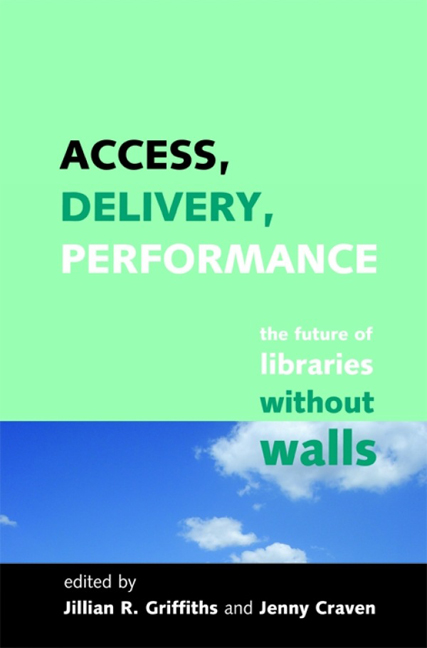Book contents
- Frontmatter
- Contents
- Contributors
- 1 Introduction
- 2 The Library Research Unit at the University of Lancaster, 1967–1972: a memoir
- Theme 1 Libraries, learning and distance learning
- Theme 2 Widening access to information
- Theme 3 Changing directions of information delivery
- Theme 4 Performance, quality and leadership
- 10 An evaluation decision-making system: development and implementation of a web-based evaluation learning and instructional tool
- 11 Measuring the quality of academic library electronic services and resources
- 12 Influential leadership for academic libraries
- Peter Brophy: a selected bibliography
- Index
10 - An evaluation decision-making system: development and implementation of a web-based evaluation learning and instructional tool
from Theme 4 - Performance, quality and leadership
Published online by Cambridge University Press: 08 June 2018
- Frontmatter
- Contents
- Contributors
- 1 Introduction
- 2 The Library Research Unit at the University of Lancaster, 1967–1972: a memoir
- Theme 1 Libraries, learning and distance learning
- Theme 2 Widening access to information
- Theme 3 Changing directions of information delivery
- Theme 4 Performance, quality and leadership
- 10 An evaluation decision-making system: development and implementation of a web-based evaluation learning and instructional tool
- 11 Measuring the quality of academic library electronic services and resources
- 12 Influential leadership for academic libraries
- Peter Brophy: a selected bibliography
- Index
Summary
… libraries need to develop services that enable and encourage users not simply to be passive receptors of information, but themselves to create new information and other objects that they can share with their worldwide community.
Peter Brophy (2004, 14)US public libraries received $9.7 billion in operating income in FY 2005 (National Center for Education Statistics, 2008): 81% from local sources, 10% from state sources, 1% from federal sources, and 8% from other sources (gifts, fines, donations, and so on). Regardless of how much each individual library received, public library administrators and librarians are under increasing pressure to articulate the value and impacts of their library services and resources to these sources of funds. The process for determining value, impacts, outcomes, satisfaction and so on increasingly requires more attention and more tools. The project described here is one attempt to assist public library administrators to develop better evaluation tools.
Researchers and library practitioners have developed a number of evaluation strategies and tools to help libraries articulate value, impact, quality and other benefits related to the use of services and resources. Identification of the best evaluation methods to use as part of these strategies, however, and obtaining access to sources of information capable of providing useful service and resource data, presents a formidable task for many libraries. Oftentimes, methods and evaluation tools are not compared against each other nor do they take into consideration local situational factors that may affect the success with which these tools can be implemented.
The project described in this paper, an evaluation decision management system (EDMS) (EDMS, 2008, available at www.libevaluation.com/edms), addresses how public libraries:
• develop evaluation strategies to demonstrate value and impacts
• identify the best evaluation methods for these strategies
• access a range of service and resource data from national library-based databases.
Public libraries can address the above through a centralized online portal that encourages users to share and create a range of information related to evaluation. In addition, this paper identifies issues related to the development and implementation of a web-based instructional system and assesses the effects of technology development on evaluation of networked services and resources. Although the project is currently under development as this paper is written (2008), a number of lessons have been learned that may be of use to others developing such an evaluation tool.
- Type
- Chapter
- Information
- Access, Delivery, PerformanceThe Future of Libraries Without Walls, pp. 161 - 182Publisher: FacetPrint publication year: 2008

